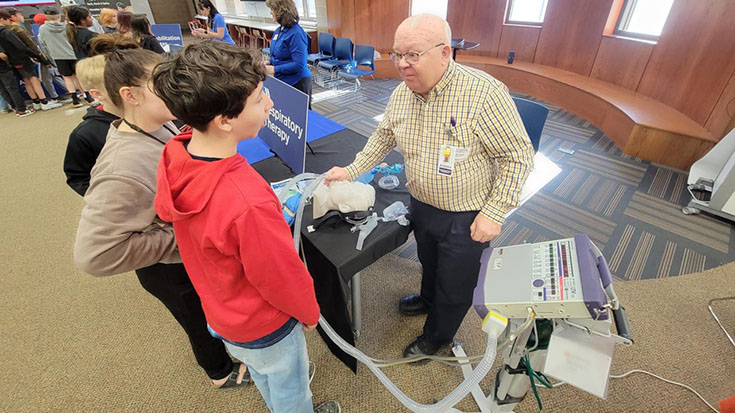
Succession planning is an important process for respiratory care departments, and it needs to begin much sooner than you might think.
“Sam Giordano, former AARC executive director, mentor, and friend, told me years ago that you have to identify 4-5 individuals at least 8-10 years before the time you need them to take a leadership role,” said Garry W. Kauffman, MPA, RRT, FAARC, FACHE, a respiratory care consultant with a long history in departmental management. “This has been some of the best advice I’ve ever gotten.”
But how do you find these “hidden leaders” in your department, and once you do, what does it take to ensure they will be ready to assume a formal leadership role when the time is right?
Kauffman joins Matthew S. Pavlichko, MS, RRT, RRT-NPS, director of professional development and education at Vapotherm and president of the Pennsylvania Society for Respiratory Care, in explaining the best way to go about not just finding hidden leaders in your department but also cultivating them into the kind of leaders capable of moving the department forward.
They are among us
“Hidden leaders are among us,” said Pavlichko. “Most of them don’t know they are leaders, but we do.”
These individuals can come from a variety of places within a department — bedside care, a supervisory role, clinical educator, etc. — but they all have one key trait in common: they are always ready to help their coworkers with any problem or issue that arises, clinical or otherwise.
If you think about it, you already know who these people are because they are your go-to people in the department whenever you need an extra hand.
“We rely on them, sometimes too much, because they always perform at the highest level,” said Pavlichko. “The whole department looks up to them.
Kauffman divides these hidden leaders into three categories: clinical leader, informal leader, and quiet leader.
The clinical leader possesses skills that even the department director may not have.
“I would like to think that all of us as department heads have solid clinical knowledge and skills, but it’s not to be expected that the department head can or should be the expert in all clinical areas,” he said. “One of those untitled leaders is the person with exemplary knowledge and skills in their respective clinical areas — for example, neonatal, pediatrics, rehab, ECMO.”
The informal leader is a person who has the innate ability to engage others and get them to follow their lead. Kauffman warns this is a two-sided coin.
“We’ve all seen that informal leader that can create a positive image of the department by how they conduct themselves and interact with others in the workplace,” he explained. “Conversely, and quite sadly, we’ve probably all witnessed how a negative person can suck the energy out of their teammates.”
Kauffman defines the quiet leader as someone who is great at what they do but may not seek out the spotlight. This staff member has earned the respect of their peers and could be a candidate for formal leadership in some situations as well.
Characteristics to keep in mind
Kauffman and Pavlichko cite several characteristics managers should consider when seeking out these hidden leaders in their departments.
Pavlichko recommends looking for people who desire to lead, are aware of their own strengths, know where their gaps in knowledge lie and seek ways to close them, are lifelong learners and can align their expectations to the greater good of the organization.
The latter is especially important for a formal leadership position.
“The skill to collaborate with others is a vital one,” he emphasized. “Great leaders don’t lead alone, and they share their mission with other great leaders.”
Kauffman believes managers need to be lifelong learners as well. He also wants to see great communication skills and a commitment to the organization that will carry forward into the future and whatever challenges may arise.
He also believes in the concept of servant leadership.
“While confident and knowledgeable, the servant leader places themselves at the bottom of the organizational chart and puts the front line staff at the top,” he explained, noting that this may also be referenced as ‘leading from the front’ vs. ‘leading from behind.’
Whatever you want to call it, he thinks leaders who have these skills and possess the will to use them are the ones who command the most respect and engagement from their staff.
Leadership development tips
Once you have uncovered your hidden leaders, it’s time to start developing them into the kind of people who can take over for you when the time comes.
Pavlichko offers these tips —
- Commit to them: Dedicate your time and resources to their development.
- Create a formal and detailed development plan: Assess their strengths and weaknesses, create a learning strategy, and have due dates and intentional communication with follow-up.
- Make them uncomfortable: Take them to a meeting with your boss, ask them to develop a new process, and make them lead a meeting or present a poster at Congress. You only learn when you are uncomfortable.
- Introduce them to other leaders: Your way is not the only way. Introducing them to others facilitates collaboration and growth.
Here is Kauffman’s top advice —
- Identify early: What happens all too frequently is that individuals are selected to assume a leadership role at the 11th hour. Organizations that start today to identify the next generation of leaders typically have a smoother transition in leadership.
- Make sure they are interested: We may have leaders in various informal roles, but we can’t assume that these individuals want a formal leadership role. It might be that the individual wants to further develop their leadership in their current role and not advance to what we might think is a “higher” position.
- Customize the process: Creating a development plan with the individual and getting commitment to each aspect of the plan is the most effective way to ensure proper training and development of the individual.
Maximizing your chances
Hidden leaders are everywhere in respiratory care, and you may be one of them. So how can you make sure you’re discovered by your managers and set up for a formal leadership role down the line?
Matthew Pavlichko believes your best bet is to find a mentor and work with that person to reach your leadership goals. He has done that in his own career and is still benefiting from the relationship.
“My current mentor is a great colleague who acts as my leadership coach,” he said. “He sees me how others see me, not how I see myself. He challenges my way of thinking, makes me uncomfortable, encourages my strengths, and most importantly, he dedicates his time to my growth. A great mentor can change your life.”
Garry Kauffman advises therapists to examine their reasons for wanting to take on a formal leadership role and make sure it will really be right for them — and remember that staying at the bedside doesn’t mean you can’t lead.
“We need leaders at the bedside far more than we need department heads,” he said.
But if, after careful thought, you decide this is what you want, then commit to it. That means you may need to advance your education, and you will definitely need to find a way to deal with the stress that comes with the job, not to mention the extra hours.
Finally, Kauffman says to realize that just because you may be the leader in a profession like respiratory care, you will never really be at the top of the pyramid.
“I think is critically important to understand the traditional organization chart with the front line staff at the bottom and the CEO at the top isn’t the right model for today, and in fact, was a flawed model for years,” he said. “The person at the top of the pyramid needs to be those we care for — the patients, families, and communities we serve.”
He says that’s why he became an RT in the first place, and he believes it’s why the vast majority of therapists out there today became one too.
“Develop your knowledge, skills, and competencies not for yourself but for those you serve,” he said. “In short, that’s leadership.”
Email newsroom@aarc.org with questions or comments, we’d love to hear from you.














